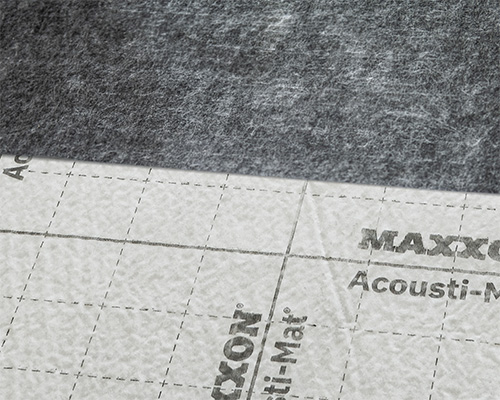Choosing the Best Solution Depends on Application
What’s the difference between topical sound mats and encapsulated sound control systems? Plenty. Especially when designing and building an effective solution for multifamily acoustical privacy.
In wood-frame multifamily construction, an encapsulated sound control system — such as Maxxon’s Acoustic Isolation System — delivers significant advantages over topical sound mats.
Advantages of Encapsulated Sound Control for Multifamily Construction:
- Superior sound control at both high- and low-frequencies
- Consistent acoustical performance regardless of flooring updates or repairs
- Permanent part of the building envelope
- Accommodates repairs and flooring renovations
- Never needs replacing — lasts for the life of the structure
- Impervious to damage
- Compatible with all popular floor coverings
Disadvantages of Topical Sound Mats for Multifamily Construction
- Less effective in mitigating low-frequency, impact-related sounds
- Performance is constrained to just above IIC code minimum for LVT/LVP
- Must be fully removed / replaced before flooring update installs
- Difficult to accommodate flooring repairs
- Deflection may cause failures
- Can cause flooring discoloration due to plasticizer migration
- Susceptible to compression and damage
Maxxon Acoustic Isolation System
Made for Multifamily Construction Sound Control
Backed by 30+ years of field- and lab-tested performance, including more than 200 published sound tests and over 140 UL and ULC fire-resistance rated designs, Maxxon’s encapsulated Acoustic Isolation System delivers a proven, trusted, and permanent solution for optimal sound control. Here’s how it works:
By encapsulating a Maxxon® Acousti-Mat® Sound Mat in a Maxxon® Gyp-Crete® Gypsum Underlayment, the Maxxon Acoustic Isolation System maintains the integrity of the air gap needed to dissipate low-frequency, impact sound. The entangled mesh mat is protected.
The top layer of fire-resistance-rated Maxxon® Gyp-Crete® Gypsum provides a solid mass to block high-frequency, airborne sound transfer. It also provides a strong, smooth, flat surface for finished flooring. Floors look better, last longer, and rooms stay quieter.
Sealing the system with Maxxon® Acousti-Mat® Perimeter Isolation Strips, eliminates sound bleed of flanking paths. Superior noise reduction is sealed in.

Where to Use Topical Mats
Topical sound mats are a suitable choice for these applications.

Older Wood Frame Multifamily Renovations
When adding an encapsulated system is not feasible, use a topical sound mat to achieve code compliance when renovating older properties.

Concrete Multifamily Construction
Because concrete satisfies fire code, gypsum underlayment is not required. In these instances, a topical sound mat can be used to meet sound code compliance.

Combined with an Encapsulated System
For renovation projects where an encapsulated sound control system exists, a topical sound mat can be added to exceed code-level performance of high-frequency sound control.

Go Deep Before Specifying Topical Sound Mats
Driven by code requirements and occupant expectations, sound attenuation in multifamily properties is an increasingly important factor in building design and construction. As the demand […]